Blog & Latest Updates
Fly Fishing Articles
Insects by Common Name


Animal Phylum Arthropoda (Arthropods)
Taxonomic Navigation -?-
Kingdom
Animalia (Animals)
» Phylum Arthropoda (Arthropods)
| Class in Arthropoda | ||
| ArachnidaMites and Spiders | 0 | 1 |
| CollembolaSpringtails | 0 | 0 |
| Crustacea-MalacostracaCrayfish, Scuds, and Sowbugs | 0 | 10 |
| Crustacea-Maxillopoda | 0 | 0 |
| InsectaInsects | 0 | 114 |
Common Name
| Match | Common Name |
| Arthropods |
This is page 6 of specimens of Arthropoda. Visit the main Arthropoda page for:
- The behavior and habitat of Arthropoda.
- 122 underwater pictures of Arthropoda.
Pictures of 1244 Arthropod Specimens:
Hexagenia limbata (Hex) Mayfly Nymph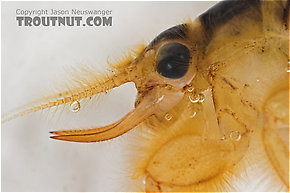 View 9 Pictures
View 9 Pictures
 View 9 Pictures
View 9 PicturesCollected June 8, 2005 from the Namekagon River in Wisconsin
Added to Troutnut.com by Troutnut on May 26, 2006
Added to Troutnut.com by Troutnut on May 26, 2006
Female Helopicus subvarians (Springfly) Stonefly Adult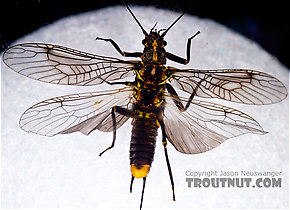 View 11 PicturesI caught this female during her egg-laying flight.
View 11 PicturesI caught this female during her egg-laying flight.
 View 11 PicturesI caught this female during her egg-laying flight.
View 11 PicturesI caught this female during her egg-laying flight.Collected June 7, 2007 from the West Branch of the Delaware River in New York
Added to Troutnut.com by Troutnut on June 8, 2007
Added to Troutnut.com by Troutnut on June 8, 2007
Male Drunella cornuta (Large Blue-Winged Olive) Mayfly Dun View 12 Pictures
View 12 Pictures
 View 12 Pictures
View 12 PicturesCollected May 29, 2007 from Brodhead Creek in Pennsylvania
Added to Troutnut.com by Troutnut on June 4, 2007
Added to Troutnut.com by Troutnut on June 4, 2007
Male Hexagenia atrocaudata (Late Hex) Mayfly Spinner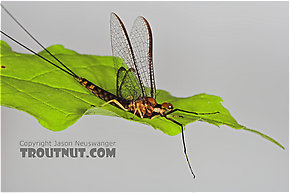 View 12 Pictures
View 12 Pictures
 View 12 Pictures
View 12 PicturesCollected July 24, 2005 from the Namekagon River in Wisconsin
Added to Troutnut.com by Troutnut on April 15, 2006
Added to Troutnut.com by Troutnut on April 15, 2006
Male Baetis tricaudatus (Blue-Winged Olive) Mayfly Dun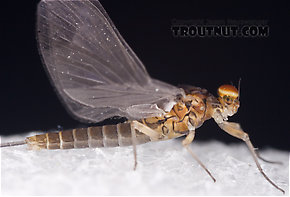 View 8 PicturesThis male was associated with a female of the same species.
View 8 PicturesThis male was associated with a female of the same species.
 View 8 PicturesThis male was associated with a female of the same species.
View 8 PicturesThis male was associated with a female of the same species.Collected April 3, 2007 from Owasco Inlet in New York
Added to Troutnut.com by Troutnut on April 3, 2007
Added to Troutnut.com by Troutnut on April 3, 2007
Neophylax (Autumn Mottled Sedges) Caddisfly Larva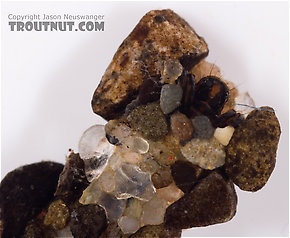 View 9 Pictures
View 9 Pictures
 View 9 Pictures
View 9 PicturesCollected March 30, 2007 from Fall Creek in New York
Added to Troutnut.com by Troutnut on April 2, 2007
Added to Troutnut.com by Troutnut on April 2, 2007
Male Baetidae (Blue-Winged Olives) Mayfly Nymph View 10 PicturesThis male nymph is probably in its final instar (Instar: Many invertebrates molt through dozens of progressively larger and better-developed stages as they grow. Each of these stages is known as an instar. Hard-bodied nymphs typically molt through more instars than soft-bodied larvae.). The wing pads (
View 10 PicturesThis male nymph is probably in its final instar (Instar: Many invertebrates molt through dozens of progressively larger and better-developed stages as they grow. Each of these stages is known as an instar. Hard-bodied nymphs typically molt through more instars than soft-bodied larvae.). The wing pads ( Wing pad: A protrusion from the thorax of an insect nymph which holds the developing wings. Black wing pads usually indicate that the nymph is nearly ready to emerge into an adult.) are extremely black and the large turbinate (
Wing pad: A protrusion from the thorax of an insect nymph which holds the developing wings. Black wing pads usually indicate that the nymph is nearly ready to emerge into an adult.) are extremely black and the large turbinate (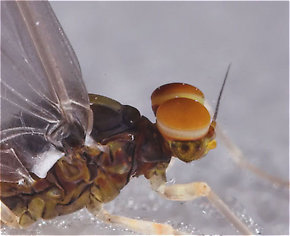 Turbinate: Shaped like a top or elevated on a stalk; usually refers to the eyes of some adult male Baetidae mayflies which are wider near the tip than at the base.) eyes are very apparent inside the nymph's head.
Turbinate: Shaped like a top or elevated on a stalk; usually refers to the eyes of some adult male Baetidae mayflies which are wider near the tip than at the base.) eyes are very apparent inside the nymph's head.
 View 10 PicturesThis male nymph is probably in its final instar (Instar: Many invertebrates molt through dozens of progressively larger and better-developed stages as they grow. Each of these stages is known as an instar. Hard-bodied nymphs typically molt through more instars than soft-bodied larvae.). The wing pads (
View 10 PicturesThis male nymph is probably in its final instar (Instar: Many invertebrates molt through dozens of progressively larger and better-developed stages as they grow. Each of these stages is known as an instar. Hard-bodied nymphs typically molt through more instars than soft-bodied larvae.). The wing pads (
The wing pads on this final instar Baetidae mayfly nymph are extremely dark.

This male Baetidae dun has slightly turbinate eyes.
Collected June 9, 2005 from the Bois Brule River in Wisconsin
Added to Troutnut.com by Troutnut on May 26, 2006
Added to Troutnut.com by Troutnut on May 26, 2006
Female Maccaffertium ithaca (Light Cahill) Mayfly Dun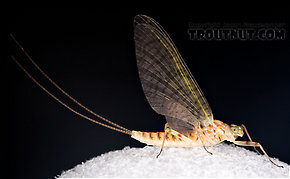 View 10 PicturesThis female looks very much like a male I collected a few hundred miles away a few days later, so I'm guessing it's the same species, which I believe is Maccaffertium mediopunctatum.
View 10 PicturesThis female looks very much like a male I collected a few hundred miles away a few days later, so I'm guessing it's the same species, which I believe is Maccaffertium mediopunctatum.
 View 10 PicturesThis female looks very much like a male I collected a few hundred miles away a few days later, so I'm guessing it's the same species, which I believe is Maccaffertium mediopunctatum.
View 10 PicturesThis female looks very much like a male I collected a few hundred miles away a few days later, so I'm guessing it's the same species, which I believe is Maccaffertium mediopunctatum.Collected May 23, 2007 from the Little Juniata River in Pennsylvania
Added to Troutnut.com by Troutnut on June 4, 2007
Added to Troutnut.com by Troutnut on June 4, 2007
Male Ephemerella aurivillii Mayfly Dun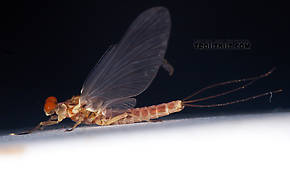 View 14 PicturesThis is the most widespread species of Ephemerella, and also the most abundant in some places, but nobody I've talked to seemed to know what its duns looked like, and there were no pictures of its duns online or in any angling books. That mystery is solved with this male dun, which hatched from a definitively identified nymph.
View 14 PicturesThis is the most widespread species of Ephemerella, and also the most abundant in some places, but nobody I've talked to seemed to know what its duns looked like, and there were no pictures of its duns online or in any angling books. That mystery is solved with this male dun, which hatched from a definitively identified nymph.
 View 14 PicturesThis is the most widespread species of Ephemerella, and also the most abundant in some places, but nobody I've talked to seemed to know what its duns looked like, and there were no pictures of its duns online or in any angling books. That mystery is solved with this male dun, which hatched from a definitively identified nymph.
View 14 PicturesThis is the most widespread species of Ephemerella, and also the most abundant in some places, but nobody I've talked to seemed to know what its duns looked like, and there were no pictures of its duns online or in any angling books. That mystery is solved with this male dun, which hatched from a definitively identified nymph.Male Maccaffertium vicarium (March Brown) Mayfly Dun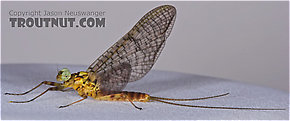 View 10 PicturesI collected this mayfly on the same trip as a female of the same species. After these photos it molted into a spinner. This is the form of Maccaffertium vicarium which anglers call the "Gray Fox."
View 10 PicturesI collected this mayfly on the same trip as a female of the same species. After these photos it molted into a spinner. This is the form of Maccaffertium vicarium which anglers call the "Gray Fox."
 View 10 PicturesI collected this mayfly on the same trip as a female of the same species. After these photos it molted into a spinner. This is the form of Maccaffertium vicarium which anglers call the "Gray Fox."
View 10 PicturesI collected this mayfly on the same trip as a female of the same species. After these photos it molted into a spinner. This is the form of Maccaffertium vicarium which anglers call the "Gray Fox."Collected May 28, 2005 from the Namekagon River in Wisconsin
Added to Troutnut.com by Troutnut on May 24, 2006
Added to Troutnut.com by Troutnut on May 24, 2006
Top 10 Fly Hatches
Top Gift Shop Designs
Eat mayflies.
Top Insect Specimens
Miscellaneous Sites
Troutnut.com is copyright © 2004-2024 Jason
Neuswanger (email Jason). See my FAQ for information about use of my images.
 privacy policy
privacy policy
